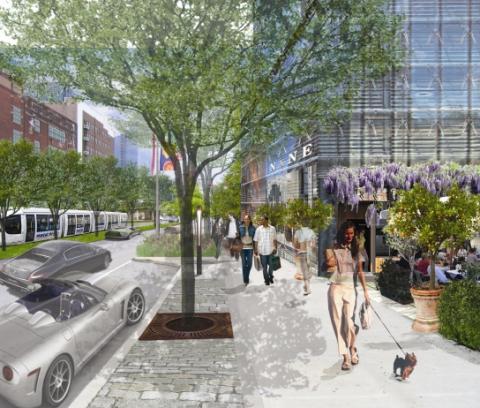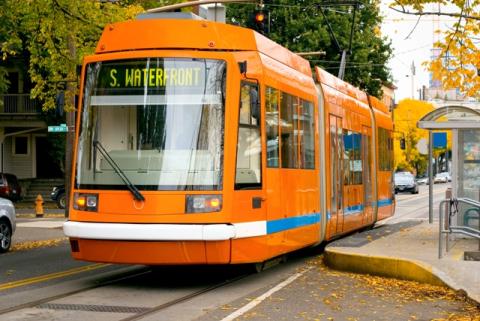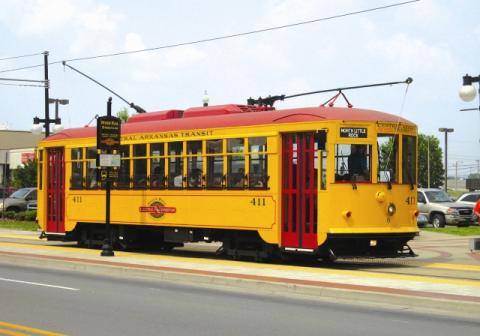Stuart Weitzman School of Design
102 Meyerson Hall
210 South 34th Street
Philadelphia, PA 19104
Get the latest Weitzman news in your Inbox
In cities across the nation, energy-efficient, frequent-service streetcars have attracted significant private investment.
Plans for the future of the central Delaware must include a reliable transit system that can bring residents and visitors to and from the river. Currently, only buses provide service to the river, and only one bus carries riders north and south along a significant stretch of the central Delaware: Bus 25 (44). This action plan recommends that a streetcar line be built along an existing right-of-way. This new line will transport residents to the river, reduce traffic congestion and create new economic-development opportunities. Streetcars provide an excellent return on investment. In cities across the nation, energy-efficient, frequent-service streetcars have attracted significant private investment.

By adding a streetcar line along the median where a right-of-way already exists, we add the equivalent capacity of two and a half car lanes in each direction. One high-frequency streetcar line using large, modern vehicles can transport two to three thousand passengers per hour in each direction. That is the same number of people that five (of the six total) car-traffic lanes can carry now (45 ). The reduction in car traffic will be critical once further development occurs, as the existing Delaware Avenue/Columbus Boulevard will not be able to absorb the anticipated increase in auto traffic. In addition, a streetcar line will open up the river to the large numbers of Philadelphians who do not own cars—53 percent of Center City residents and 45 percent of South Philadelphia residents.

The above cross-section shows how existing right-of-way down the center of Columbus Boulevard can be used to accommodate transit that will significantly increase the corridor's efficiency. In order to achieve this ultimate vision, it is imperative that the city maintain this existing right-of-way.
The existing right-of-way along the median of Delaware Avenue/Columbus Boulevard could accommodate a streetcar line. The right-of-way in the median of Delaware Avenue/Columbus Boulevard extends south from Race Street past Oregon Avenue to the Packer Avenue Marine Terminal at Hoyt Street. It is held by the Philadelphia Belt Line Railroad Company as a part of a century-old agreement with the city (46). The greatest cost of creating a streetcar line is acquiring a right-of-way on which to locate the tracks, which will not be necessary in this case, as the Delaware Boulevard median provides an existing and underutilized right-of-way that will substantially reduce start-up costs. It is therefore essential to the future of the riverfront that the right-of-way be preserved.
Buses must improve transit access in the short term. Transit users must have suitable, reliable transit service during the streetcar’s planning and construction phases, and frequent bus service will fill that need. Even after streetcar service begins, buses will need to offer service to the riverfront from areas of the city that will not have convenient connections to the streetcar line.
The Port Authority Transit Corporation (PATCO), our bistate transit agency, is evaluating three alternative plans to finance and build a streetcar or trolley line along the central Delaware. This effort is a part of their Alternatives Analysis, the first phase of project development for major transit investments that seek federal funding from the Federal Transit Administration (47). PATCO hopes to decide on the best possible route in 2008. Each of the three routes being considered will create or extend a trolley or streetcar line north-south along the river within the Belt Line right-of-way that PATCO says is available, pending negotiations with the railroad on Columbus Boulevard (48). Each of these new transit-line alternatives will take six to ten years to complete. Each will require the streetcar to share tracks with freight rail by operating at different times than Southern New Jersey’s Riverline and Baltimore passenger rail (49). All three plans call for connection to the SEPTA (Southeastern Pennsylvania Transportation Authority) and PATCO transit systems and for a joint fare agreement between PATCO and SEPTA that will allow easy transfers (50).
Streetcars attract $10 of private investment for every public dollar spent

Portland's streetcar line has generated $1.1 billion of development near its tracks.
Short-Term Actions
- Preserve the rail right-of-way along Delaware Avenue/Columbus Boulevard median for future transit use.
- SEPTA will continue to work with the city to modify and/or expand bus-route options for getting to and traveling along the river.
- Create better pedestrian connections from transit stops to the river.
- Build safe, comfortable transit shelters along Delaware Boulevard.
- Monitor PATCO process and advocate for a central Delaware streetcar.
Longer-Term Actions
- A feasibility study should be conducted to determine the type of streetcar line that will prove most feasible and beneficial.
- Partner with SEPTA and PATCO to obtain federal funding to create streetcar line.
- Install new streetcar line so that it connects with SEPTA and PATCO transit networks.
- Enhance ferry service and begin water-taxi service to New Jersey along the Pennsylvania side of the river shoreline.
Civic Actions: What Philadelphians Can Do
- Work to preserve the right-of-way along the Delaware Avenue/Columbus Boulevard median for a future streetcar line. Oppose any plans to place a vehicle turn lane over the median.
- Support PATCO’s proposed transit line on the central Delaware. Community support at public meetings will help at the local selection level and will help PATCO succeed with its application for federal transportation funding.
- Work with SEPTA and Philadelphia’s Office of Transportation to identify additional bus routes that will improve access to the river in the short term.
- Identify the most popular transit stops, which should be priority locations for transit shelters.
Benefits and Impact
Economic: Attracts $10 investment for every $1 of public investment, improves worker mobility and limits parking needs.
Environmental: Increases transit ridership, decreases automobile pollution linked to asthma and improves air quality.
Community: Improves access to the river, connects residents to the river and reduces traffic congestion.
Impact on City Budget: PATCO is currently studying $1 billion in transit-system extensions, but most of that cost is due to tunneling to reach stops in Center City. On its own, construction of a streetcar line costs $20 to $35 million per mile (52). The Girard Avenue Trolley Line, an 8.5-mile trolley line, was reinstated by SEPTA in 2005 for a total cost of $88 million. Portland’s original 2.4-mile streetcar line was put in place for a cost of $56.9 million. Any transit alternative will be funded with federal transportation funds and matched by funding from the state, the city and the Delaware River Port Authority (DRPA) (53).
Other Cities Have Done It - We Can Too
In several cities, such as San Francisco and New Orleans, streetcars have never gone out of style as transportation systems. Today, cities are building or have plans to build new streetcar lines—from Tucson, AZ and Miami, FL to Birmingham, AL and Trenton, NJ. The streetcar is a proven draw for investment in houses, stores and restaurants. In Little Rock, AK, a streetcar reconnected the river with downtown. Little Rock opened its 2.5-mile River Rail streetcar in 2004. To date, about $200 million in development has either been planned or built along the $19.6-million line. And in Portland, OR, the streetcar system has helped bring $2.7 billion in investment within two blocks of its 3.6-mile line, transforming the Pearl District into one of the most vibrant neighborhoods in the city.

In 2004, Little Rock opened a streetcar line that reconnected the river with its downtown.
Funding Resources
The state, city and DRPA will need to raise a match to the federal transportation funds. Potential funding resources to meet that matching grant requirement include bonds, TIFs, parking-garage revenue and general funds. Contributions from private companies that will benefit greatly from the line could also be sought to make this a true public-private partnership.
